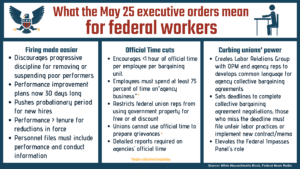
What changes (and doesn’t) under Trump’s new employee removal executive order
The president's new executive order on the employee removal process makes some significant changes for federal workers.
Best listening experience is on Chrome, Firefox or Safari. Subscribe to Federal Drive’s daily audio interviews on Apple Podcasts or PodcastOne.
Though the three executive orders the president signed late Friday afternoon may have caught the federal community by surprise, recent actions by the Trump administration have hinted about the direction the White House wants to go.
Administration officials told reporters last week the orders fulfilled a promise President Donald Trump made during his state of the union speech earlier this year, when he called on Congress to empower all cabinet secretaries to reward good employees and remove those “who undermine the public trust of fail the American people.”
In his speech, Trump cited success with the Veterans Affairs Accountability and Whistleblower Protection Act, which he signed into law last summer.
But Trump isn’t calling on Congress to do much of anything with these executive orders. After all, the president’s latest directives are limited by current law and statute. And federal experts say the president — particularly in his executive order on “Promoting Accountability and Streamlining Removal Procedures Consistent with Merit System Principles” could have done more to tighten disciplinary procedures for federal employees and processes for agencies.
Federal News Radio this week will review each of the president’s latest executive orders for the federal workforce in more depth. Here are just some of the biggest changes federal employees may see under the president’s new accountability and removal executive order.
Shorter performance improvement periods
The executive order specifically standardizes the length of an employee performance improvement plan (PIP) to 30 days. Currently, some agencies give their employees anywhere from 30 to 120 days to demonstrate their level of performance.
The Health and Human Services Department recently changed the length of its performance improvement plans to 30 days. The Veterans Benefits Administration at one point changed the PIP timeline to 30 days, though the agency rescinded that guidance in April and reverted back to a previous memo that gave no clear performance demonstration timeline.
Bill Wiley, an attorney and former chief counsel to the chairman of the Merit Systems Protection Board, said the 30-day PIP limit should provide some clarity and relief to agency supervisors. Wiley, who now trains agency supervisors and human resources specialists on federal employee law as the co-founder of the Federal Law Training Group, said he often receives questions about the time employees should have to improve their performance.
“That should be a great relief for supervisors who have been hesitant to hold people accountable,” Wiley said. “It’s easier to commit to a month than three or four months.”
The order also leaves supervisors some room to determine how they will discipline and manage employees who are not meeting performance standards.
“Supervisors and deciding officials should not be required to use progressive discipline,” the order said. “The penalty for an instance of misconduct should be tailored to the facts and circumstances.”
“Progressive discipline” typically refers to the concept that supervisors may give their employees one or more opportunities to improve their performance after the first offense.
Jeff Neal, a former chief human capital officer at the Homeland Security Department and now senior vice president for ICF, said the order could have offered mandatory remedies for specific types of misconduct.
But the order doesn’t do that. Instead, the EO clarifies that agencies consider the facts, performance and circumstances of an employee’s specific situation to determine what kind of personnel action it should take.
“When taking disciplinary action, agencies should have discretion to take into account an employee’s disciplinary record and past work record, including all past misconduct — not only similar past misconduct,” the order said.
Wiley said the EO’s language appears to reference and contradict a series of decisions that MSPB issued in 2010, which determine that an agency must implement the same remedies for the same or similar misconduct throughout an agency.
Moving forward, agencies must prioritize an employee’s performance over their length of service when determining which workers will go during a reduction in force (RIF), the order said.
This change is especially significant, Neal said. For most agencies, with the exception of the Defense Department, the employees with the fewest years of federal service are often the first to go during a RIF.
Current law lists the factors that agencies should consider when determining who will go during a RIF. But the law doesn’t specify what order agencies should prioritize those factors, Neal said. This EO makes it clear what agencies should consider first when RIFing their employees, and the Office of Personnel Management would likely have to make this change through new regulations.
Limits to union grievances
The EO also prevents federal unions from using the grievance process to appeal employee terminations,
“That historically has been a big, big benefit for federal employees and collective bargaining units, because an arbitrator is more likely, perhaps even much more likely, to set aside a removal than … an MSPB judge, which is the alternative,” Wiley said.
Collective bargaining unit employees have two main paths to appeal a major disciplinary action: the negotiated union grievance process or the administrative process. Typically, bargaining unit employees can file a grievance with their union. From there, the employees who lose the grievance will typically receive an arbitration hearing, and the arbitrator will issue a decision.
But according to the order, employees in a collective bargaining unit can no longer take their termination cases to an arbitrator.
“Out of all the things and all the executive orders, if the person is a bargaining unit, that’s the greatest change that comes out of here,” Wiley said.
Employees still have the option to take their appeals to the MSPB or even the Federal District Court or regional U.S. Court of Appeals. But employees often have better luck in arbitration, and MSPB statistically sides with the agency 80-to-90 percent of the time.
Fewer chances to settle
In addition, the EO prevents agencies from expunging or erasing a disciplinary action and its outcome from an employee’s personnel file “as part of, or as a condition to, resolving a formal or informal complaint by the employee or settling an administrative challenge to an adverse personnel action.”
Both Neal and Wiley say this provision could impact agencies’ ability to settle with employees in order to speed up the removal process. Agencies may often decide to remove such information about an employee’s performance or conduct from a personnel file to resolve the appeals process and remove the employee from the organization more quickly.
“It takes away one of the great bargaining chips agencies have in trying to get employees to leave voluntarily,” Wiley said. “If you quit voluntarily, we’ll take this out of your record.”
In return, the employee with a clean record could get another job with another agency or organization. In detailing this EO, the Trump administration said this was an outcome it specifically wanted to avoid.
Next steps
The EO also requires that agencies submit reports to OPM describing the number of its employees on probationary periods, the number of personnel actions it took and the outcomes of those actions, among other details. OPM will compile and publish agency reports every year.
But those reports may be difficult for agencies to compile, Neal said. Most agencies lack the human resources systems they need to report this information with the requested detail.
The Veterans Affairs Department for example, received similar reporting mandates in its accountability act. But VA has been unable to produce those reports for Congress, citing limitations with its current HR SMART system.
OPM has its own requirement to issue implementation guidance for this EO within 60 days. Within 45 days, the agency must examine whether existing regulations can achieve the mandates of the president’s executive order, or whether OPM must propose additional regulations to implement the EO.
Individual agencies must review and revise their own discipline and unacceptable performance policies to conform with the new order. In addition, agencies must renegotiate any collective bargaining agreements that are inconsistent with the EO.
Copyright © 2025 Federal News Network. All rights reserved. This website is not intended for users located within the European Economic Area.
Nicole Ogrysko is a reporter for Federal News Network focusing on the federal workforce and federal pay and benefits.
Follow @nogryskoWFED
Related Stories

Trump signs executive orders making it easier to fire feds, overhaul official time

Official time debate takes center stage again with OPM’s latest data
 Exclusive
Exclusive 



